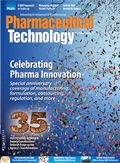Pharmaceutical Technology: 35 Years and Going Strong
Taking time to appreciate the industry's greatest achievements will inspire growth ahead.
I'm going into my sixth year working on PharmTech and it's been quite an exciting few years given the changing industry dynamics and major shifts in regulation—both of which are becoming more global and more transparent. It's also an exciting time because Pharmaceutical Technology is celebrating its 35th anniversary. In fact, you'll find unique retrospectives and forward-looking pieces from industry experts throughout the pages of this issue and on our website, at PharmTech.com.

Angie Drakulich
One area of change that I've been following closely is the globalization of the industry. Companies are now expected to perform site visits and audits of all of their suppliers and contact service providers in addition to the multiple audits that they must host from regulators each year. It's been fascinating to watch industry form its own consortiums and third-party auditing schemes to address these needs. The industry is becoming more open to sharing information as well, which is quite a feat in a patent-driven environment.
At the same time, FDA has taken a much stronger stance during the past few years—and really the agency has had to do this—to manage the complexities of the pharmaceutical supply chain and related challenges, such as counterfeiting and economically motivated adulteration. Our Washington Editor Jill Wechsler had the opportunity to speak with FDA's Deputy Commissioner Deborah Author about these issues and where the agency is headed to meet the ever-expanding needs that come with globalization. See "FDA Adopts New Strategies to Oversee Global Economy", or listen to the full interview as a podcast on PharmTech.com.
Industry is also making great strides in the way it approaches manufacturing and testing as it works to implement risk- and quality-based approaches. People are questioning current practice and seeking ways to find and share best practices. We're especially seeing this in the area of impurities and visible particles (see "Atypical Visible Particles"), as well as in continuous processing and platform approaches. In this anniversary issue, we take a look back at how manufacturing, drug delivery and formulation, analytical methods, and outsourcing have changed in terms of key achievements and trends. In addition, experts, including the presidents of PhRMA, BIO, and AAPS (see "Future Innovation"), provide their views on what the future holds for the industry.
I am happy to say that PharmTech is, and has been, right in the middle of these issues. We are working with the industry and standard-setting organizations to get the best information available to you, whether it's the latest monograph change or FDA-issued guidance, troubleshooting tips for equipment and processing, emerging pipeline and business strategies, or novel approaches to manufacturing. We believe that this magazine offers the most relevant material for the global industry as it carries out day-to-day work, and we intend to continue carrying out that mission.
Looking ahead to the next 35 years, PharmTech is taking advantage of the industry's transformation and regulatory dynamics to make some changes of its own. Readers and online users are already taking part in our growing online communities through LinkedIn and Twitter (check out the PharmTechGroup feeds). We're also planning to make some visual changes to the magazine in the coming months. Overall, I'm quite excited about what the future has in store and hope to bring you along with us.
Angie Drakulich is editorial director of Pharmaceutical Technology. Send your thoughts and story ideas to adrakulich@advanstar.com.

Pharmaceutical Tariffs Are Imminent: How Industry is Bracing for Impact
April 16th 2025On April 14, 2025, the Trump Administration launched a national security-driven investigation into pharmaceuticals, a move that will likely result in tariffs being placed on pharmaceutical drugs, ingredients, and other components that are imported from outside of the United States.